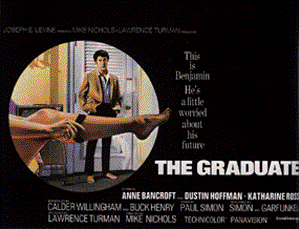 :
Study
Questions: Week Four
:
Study
Questions: Week Four  :
Study
Questions: Week Four
:
Study
Questions: Week Four
The Counter Culture Comes Home
The Graduate (1967)
Easy Rider (1969)
Looking for America
This pair of films exemplify the changes in American culture during the 1960s. In many ways, these films are similar in subject. Both criticize the manner in which a set of ideals expressed in films like The Caine Mutiny (1954) and The Man in the Gray Flannel Suit (1957) can become a stifling combination of material prosperity and a repressive narrow-mindedness. Many of the same narrative motifs can be found in each film: the flight from suburban life as exemplified in Southern California, the increasing estrangement between members the post-World War II generation (Baby boomers) and their parents, and the intellectual and spiritual emptiness haunting apparently fortunate members of the middle class (to mention only a few of the more obvious similarities).
What we want to explore are the very different perspectives from which each film critiques the American life and the significance of the ways in which the central characters attempt (often fruitlessly) to discover a better way of living. Mike Nichols' The Graduate employs the conventions of the romantic melodrama to expose and satirize the values which this genre generally endorses. The Graduate offers a bleak prospect for the young lovers who resist being entrapped in the sterile, country-club world of their parents. The questions below should help sort out the differences in the way the films treat the American Dream. Easy Rider paints an even darker picture of contemporary by reworking the conventions of the road movie, a narrative in which the central character(s) set out in search of an ideal of freedom which their society seems to have abandoned.
1. How is TV associated with a misunderstanding of the true American Dream throughout The Graduate?
2. How does the opening sequence before and behind the credits establish the film's setting and its satiric thrust? What is implied in the opening line: "We are about to descend into Los Angeles"? How might this be understood as the hero's descent from ivory tower innocence into contemporary America? How might the sequence be compared and contrasted to the opening of Easy Rider?
3. What is your interpretation of the expression on Ben Braddock's face during the first part of the film? What does his expression suggest about his future and about his willingness to pursue the American Dream?
4. What is, in your estimation, the symbolic significance of the repeated images of fish, water, and floating? How are they related to the film's central theme?
5. Why does Mrs. Robinson go to such lengths to seduce Ben? What would you say her motives might be? Don't oversimplify.
6. Contrast Ben Braddock and Captain America (Peter Fonda) as characters and as rebels against the American Dream. In what ways are they moving in the opposite direction in their desire to escape it? See also Question 10 below.
7. Is Ben a rebel breaking free to begin a new life, or is he just rebelling with no goals in mind? (Consider the film's final shot and his expression).
8. What evidence can you see that he might become the next generation's version of his own (and Elaine's) parents?
9. What, finally, is the significance of the line "The future is plastics"?
10. How do the opening sequences of Easy Rider equate American cultural values with the Counter Culture? Consider the names and costumes of the central characters, their motives for heading east to Washington D.C., and the manner in which they finance their trip.
11. How does the commune visited by Captain America and Billy dramatize an idea of community antithetical to the world of the Braddocks? Consider personal relationships, governance, geography, etc.
12. What is revealed about the Southern (probably Mississippi) town by having the protagonists arrive during a holiday parade? Is their behavior as charming as the film suggests it is? Why? Why not?
13. How does the character portrayed by a young Jack Nicholson serve as a bridge between two cultures, and how does his fate suggest the ultimate incompatibility of the two cultures? And how does it forshadow the film's climax?
14. What is the thematic significance (if any) if the scene in the New Orleans cemetery?
15. Mardi Gras, the pre-Lenten festival the protagonists attend is equated with freedom from moral and social restraints, the "easy riding" they choose as the alternative to social norms. In what significant way is the festival different from the endless high pursued by Captain America and Billy?
16. An often repeated criticism of Easy Rider finds fault with stereotypical characters and events. To what degree would you agree with this judgment.